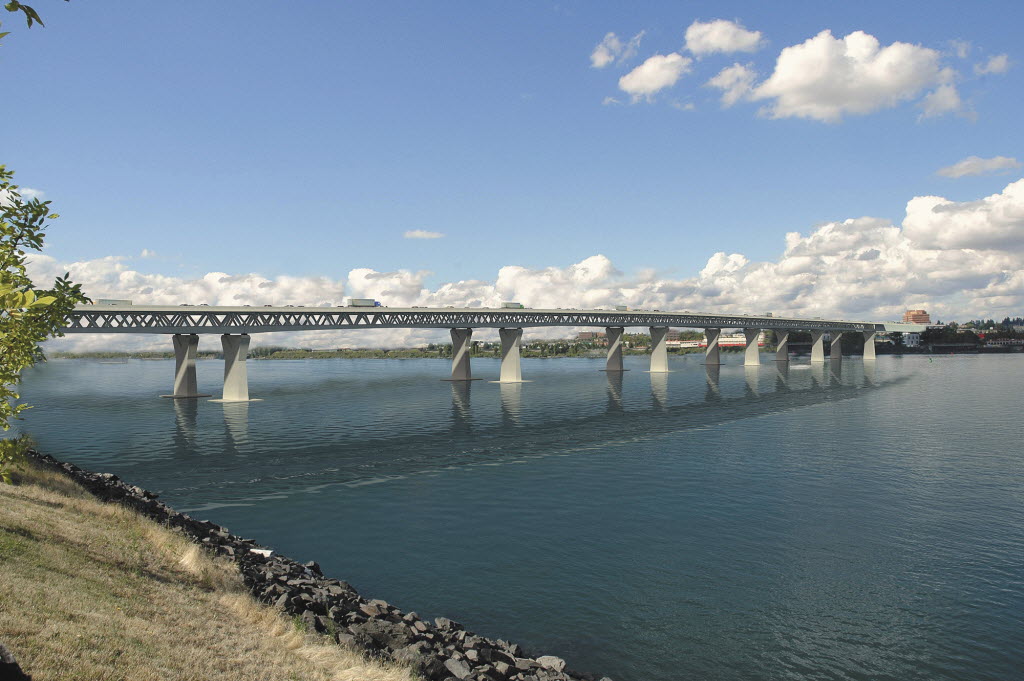Wednesday’s poll reflected the opinions of 400 Portland-area drivers, but only 52 Clark County residents. That’s because the data was collected as part of a larger set of surveys in April, according to PEMCO Insurance. Though 600 Washington residents were surveyed in total, only the 52 from Clark County were included in the Columbia River Crossing results, according to the insurance company, which commissioned the poll.
A majority of Portland and Vancouver drivers say they’ll likely head for the Glenn Jackson Bridge once tolling begins on the Interstate 5 Bridge, according to a poll released Wednesday.
A total of 54 percent of respondents — 77 percent of drivers in Clark County and 52 percent of Portland-area motorists — said they’d skip tolls on I-5 by using toll-free Interstate 205 between Vancouver and Portland.
Just 33 percent said they would be undeterred when tolling starts on the I-5 Bridge to help pay for its replacement, the Columbia River Crossing. Other respondents indicated they’ll opt for an alternative option such as carpooling, public transit or telecommuting, according to the poll commissioned by PEMCO Insurance.
Wednesday's poll reflected the opinions of 400 Portland-area drivers, but only 52 Clark County residents. That's because the data was collected as part of a larger set of surveys in April, according to PEMCO Insurance. Though 600 Washington residents were surveyed in total, only the 52 from Clark County were included in the Columbia River Crossing results, according to the insurance company, which commissioned the poll.
This week’s poll, conducted by Seattle-based FBK Research, surveyed 400 people in the Portland metro area and 52 in Clark County, according to PEMCO. That gives it a 5 percent margin of error for the Portland results, and a nearly 14 percent margin of error for Clark County’s numbers, the insurance company said.
Tolls are a major piece of the $3.5 billion CRC finance plan, along with state and federal funding sources. Earlier revenue projections from tolling were found to be unrealistic and unlikely to generate as much money as project leaders had initially banked on. An investment-grade analysis now under way is expected to give more current numbers next year.
It’s unclear how the poll results will translate into actual traffic counts. Some commuters may change their minds once they see how things play out on the two freeways, PEMCO spokesman Jon Osterberg said in a statement.
“With so many drivers saying they’ll divert their route, it’s likely that I-205 would become congested,” Osterberg said. “Perhaps more drivers will choose convenience over savings and end up joining the 33 percent who plan to stay their course despite the toll.”
State Rep. Jim Moeller, D-Vancouver, agreed.
“It wasn’t unexpected that there would be some diversion from the tolling,” said Moeller, who also sits on a legislative oversight committee on the CRC. “My belief is that once people get used to the idea … they’ll choose convenience over congestion every day.”
Of course, the amount of traffic diversion will depend on the actual toll rates set by the Washington and Oregon transportation commissions. The investment-grade analysis will likely go a long way in determining those numbers.
Last year, the Washington State Department of Transportation began tolling the Seattle area’s state Highway 520 floating bridge over Lake Washington. Traffic levels initially dropped by 30 to 40 percent as thousands of commuters opted for nearby Interstate 90. But as recently as last month, WSDOT reported traffic and revenue numbers on Highway 520 were meeting or exceeding projections.
As of September, traffic volume on the Highway 520 Bridge was about 33 percent below pre-tolling levels, said WSDOT spokeswoman Emily Pace.
CRC and state transportation officials have previously been hesitant to make direct comparisons between I-5 and Highway 520, saying every roadway is different. Clark County’s economic condition may also play a role in how drivers respond to tolls.
The CRC survey data was collected as part of a larger set of poll questions in April, Osterberg said in an interview. Pollsters contacted 600 Washington residents in all, but only the 52 of those from Clark County were included in the CRC results, he said — that’s the reason for the relatively small local sample size.
Tolling on the I-5 Bridge, which the Washington Legislature authorized earlier this year, could begin as soon as 2015, according to the CRC. Major construction on the project, which would also extend light rail into Vancouver and rebuild the freeway on both sides of the Columbia River, could begin in late 2014.
Eric Florip: 360-735-4541; http://twitter.com/col_enviro; eric.florip@columbian.com.




